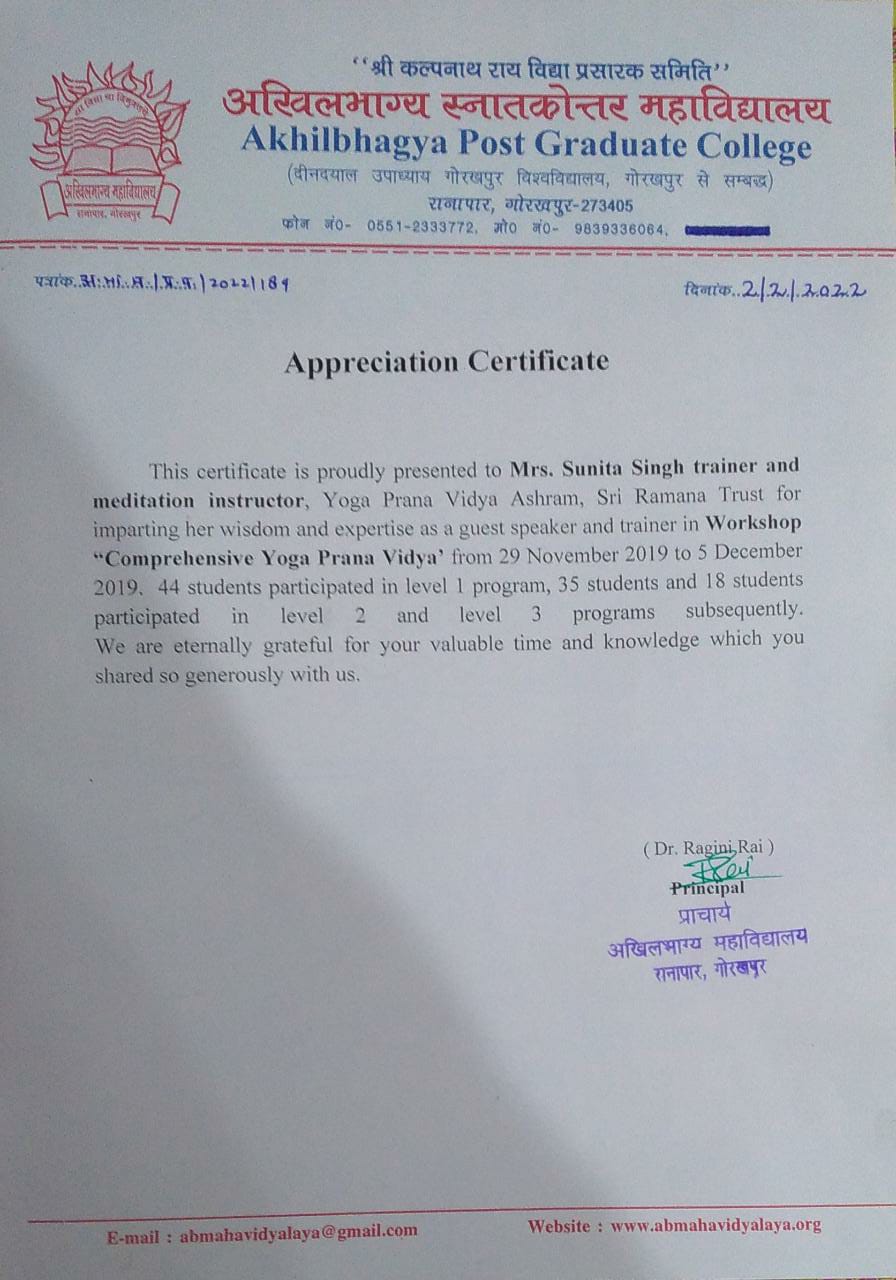The Shanti Mantra “Sahana Bhavatu…

This shloka is one of the most popular Shanti Mantras and is recited at the beginning of any study or learning. It is widely used in many schools and educational institutions, seeking for Divine Blessings and wishing to create a good environment for learning.
It has originated from the Taittiriya Upanishad. It calls for protection, fruitful learning, mutual respect between teacher and students as well as peace.
The Mantra
- OM Saha Nao Avatu (sahanavavatu)
- Saha Nao Bhunaktu
- Saha-Veeryam Kara-Vavahai
- Tejasvi Nao-Adheetam-Astu
- Maa Vid-Vishaava-Hai
Literal Translation of the Words
OM : Supreme God
Saha : together; Nao : both; Avatu : protect;
Saha : together; Nao : both; Bhunaktu : experience or rejoice;
Saha : together; Veeryam : joyful interest, enthusiasm, courage or energy; Kara-Vavahai : putting effort
Tejasvi : brilliance; Nao : both; Adheetam: study; Astu : gain
Maa: may never; Vid-Vishaava-Hai : have conflict
OM: Manifested and unmanifested Supreme Parabrahman
Shanti, Shanti, Shanti Hi: Peace, Peace, Peace – be there

Meaning of the Shanti Mantra
1. “OM Saha Nao Avatu (Sahanavavatu)”:
The student/s and the Teacher are together requesting Parabrahman for protection. The gap after OM represents unmanifested Parabrahman, who is being invoked for manifesting what we are asking for.
2. “Saha Nao Bhunaktu”:
They are both further asking together for the experience or delight for the fruit or the nectar of their study or togetherness.
3. “Saha-Veeryam Kara-Vavahai”:
They appeal to the Supreme Parabrahman that together, with joyful interest, enthusiasm and courage, may they put together tremendous effort, exercise their mental muscles, view the subject matter from different perspectives, exert to understand it, discuss, apply the knowledge, validate, seek clarification, and so on.
4. “Tejasvi Nao-Adheetam-Astu (Tejasvi naavadheetamastu):
They urge that may they together realize the brilliance from this study.
5. “Maa Vid-Vishaava-Hai”:
They pray that in the process, may they never get into any conflict. Whether the Teacher thinks that the student is not receptive or if the student doubts the teachings, in both cases, the exchange between them will not be productive. There is no joyful interest, zeal, no clarifications and no deeper study! Any doubts arising during the discussion must bring to light other facets of truth and not friction. So, they wish here that may they trust each other, co-operate, align and learn in harmony. Both must maintain their Heart centres big to achieve this.
6. “OM Shanti, Shanti, Shanti Hi”:
The repetition of the word “Shanti” has a specific purpose. There are multiple connotations.
One is, by chanting this line, we are seeking peace or purification on the Physical plane. Also, for peace on the Emotional plane by relieving us of the unwholesome feelings. And finally, for peace on the Mental plane by ridding ourselves of the unpleasant thoughts and worries. Peace is automatically prevailing on the Intuitional plane and higher. Hence, we are asking for peace in the lower three quarters of OM (A, U, M), that is, the Jagrut, Swapna and Sushupti. The fourth quarter, or the ardha matra of OM, is always in peace (i.e., Intuitional plane and all above). These quarters of OM represent our bodies and consciousness in various planes of manifestation and beyond.
Another inference is that we are asking for peace from all the known causes of suffering. Like, we are in discomfort as someone troubled us or because we have wronged someone that we know of. Additionally, we are asking for peace from the suffering that is not known to us. That is, we have caused pain to someone unknowingly or have forgotten about it or some unknown fear. However, the effect of discomfort is there. And finally, we are requesting for peace from any disturbance arising from inside of us. Like, not able to forgive our own self or discomfort within. If we understand the practice of Forgiveness, we can use it to forgive others, ask for forgiveness and forgive ourselves. Then, there will be peace at all the three levels.
Summarise
Let us quickly sum up the meaning of this shanti mantra – May the Supreme Parabrahman protect both the Teacher and the student/s. May He help them enjoy the nectar of their deep study. May they together put effort with joyful interest, enthusiasm and understand deeper meaning of the scriptures or text. May their deeper exploration together make them brilliant, Tejaswi or illumined. May they not get into any possible conflict. May they be blessed with peace!
You may also try our YPV Sadhana app which is available in various languages. It has guided audios for the breathing exercises, Forgiveness Sadhana and Planetary Peace Meditation. These techniques also boost and sustain your immune system.
YPV Sadhana App
Download YPV Sadhana app to boost immunity, emotional balance and positive attitude towards life.
Yoga Prana Vidya Ashram Sri Ramana Trust Hosur – Thally Main Road Near Ubbanur Lake Thally, Krishnagiri Dist Tamil Nadu – 635118, INDIA
Contacts
Disclaimer :
Yoga Prana Vidya is not intended to replace other forms of healing modalities including allopathy and it is also complementary including alternative.
In case of Severe or Persisting symptoms, refer to a medical doctor and or a Certified Yoga Prana Vidya Healer.
“Currently we do not have any connection / affiliation / association with and are not authorised / represented / endorsed / certified / maintained / sponsored by Master Choa Kok Sui and/or organisations established by the Master and/or subsidiaries / affiliates of such organisations.”

Dhaval Dholakia is a certified YPV healer for 16 years. He is also a mechanical engineer and has worked in Plastic Processing Machinery for 25 years. He resides in Ahmedabad.
Dr. S. K. Singh is a Arhat Trainer having more than 20 years of YPV healing and teaching experience. He is also trained in Kriyashakti & Fengsui and completed the one year intensive program in 2016. He has organized many higher level YPV training workshops and retreats. He completed his Master’s degree in Science and has a doctorate in Environmental Biology. He hails from Varanasi.

Madhu Sudhir is a senior YPV trainer since 2004. She has trained over 2500 students and more than 50 trainers who are also propagating YPV practices. She has done YPV healing for more than 7000 people since 2006. She is the secretary of the Mysore YPV Healers Association since 2011. She is also associated with JSS University – Dental College as a guest lecturer for “Holistic wellness through YPV” for BDS 1st year students. She has also conducted various seminars on YPV teachings. She graduated in commerce from Bangalore University and also has a diploma in architecture. She also works as a Vaastu consultant for businesses, constructions, plots & houses.
Raghu N is a Arhat Trainer having over 22 years of YPV healing and teaching experience. He founded “Master YPV Trust Nanjangud” in 2019 and conducting regular service activities through this trust in his role as President. He also started the first independently located YPV centre in Nanjangud in 2014. He has previously attended the one year Spiritual Intensive Program for 2015-16 conducted in Sri Ramana Trust Ashram. He also has 7 years of experience working as a secretary at “Mysore YPV Healers Association” during which he nurtured many healers. Raghu conducts teachings in Kannada, English and Hindi languages. He has also completed a B.Sc. and B.Ed. from the Mysore University.


1: Name : Lakhsmi Devi

1. Name – Vishakha Karnani
2. address/ centre – 316, Sai Kripa Colony,
Indore 452002, Madhya Pradesh
3. educational qualification – B.A. Loreto College, Kolkata. Then worked as a photo journalist & a freelancer (children photography)
4. any paper presentation – COVID 19 case report in Innovative publication journal. July 2020
5. any specific achievements – part of the organising team in the first SIP , Pune, 2015. Thereafter involved in organising public darshan and Compassionate Parenting and nurturing programs in various cities like Indore, Nagpur, Raipur, Pune, Kolkata and Ichalkaranji (kolhapur)
6. Since 2006. Got introduced to the world of energy in Kolkata and shifted to Indore in 2008 to spread the work in Central India. Currently working in M.P, Chattisgarh, Maharashtra, Rajasthan, North East India.
Radha Ganesh is presently working for Yoga Prana Vidya Organization as Senior Arhat trainer and Ethics committee member. She is a Senior Arhat Trainer and certified YPV healer with over 18 years of experience. She completed the one-year spiritual intensive program at the YPV ashram in Thally. She has been trained in basic, advanced healing and psychotherapy at World Pranic Healing. Radha worked in Unnathi Healing Foundation Trust as a healer and trainer. She also worked in MS Ramaiiah Hospital Pranic Healing Department, Ayush Arogya Dhama. She has taught YPV teachings in several schools and also conducted classes for nursing staff, pharma students among others. She regularly conducts an Arhat Marathon on every last Sunday of the month at Karnataka Pranic Healing foundation trust since last 3 years. Radha has completed her M.A. in English from MG University, Kerala.
Yoga Prana Vidya
| Account Name : | Sri Ramana Trust |
| A/C No: | 566438417 |
| Name of Bank: | Indian Bank |
| IFSC Code: | IDIB000T060 |
| Address: | Police Station Road, Thally, Krishnagiri |















